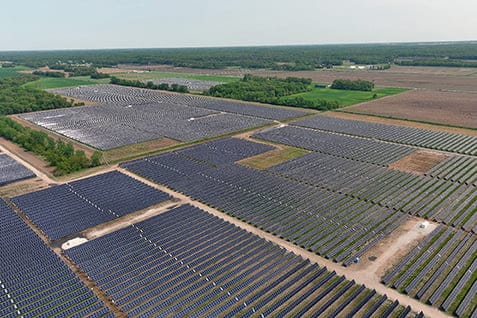Get extra (tax) credit for helping save world from effects of changing climate

The federal government is betting that Americans can be enticed to decarbonize their cars and homes with a little tax deduction love.
The Inflation Reduction Act is a package of new and enlarged energy tax incentives designed to spur a buying frenzy of electric vehicles, energy-efficient appliances and home improvements to reduce fossil fuel emissions.
Climate change roiled public discourse years before Congress passed last year’s legislation. The Environmental Protection Agency proclaimed it “the most significant climate legislation in U.S. history.”
Its supporters say the tax credits that went into effect last January will overcome any sticker shock discouraging consumers from buying clean-energy systems.
More sweeteners, like tax rebates, will soon roll out, although not before 2024 in Indiana.
How businesses can ride the IRA’s incentive wave is a little more complicated.
Business opportunities


Electric vehicle credits are available for medium- and heavy-duty commercial electric vehicles. Help for electric utility companies to pivot away from coal toward solar and wind power generation is too.
But the IRA primarily caters to individuals, say J.T. Eagan, of Purdue University Northwest, and Jaclyn Barkow, of Indiana University Northwest. The two accounting professors also run NWI Tax LLC.
“My clients aren’t buying energy efficient things just to save taxes, but when they are purchasing an electric vehicle, they come to me to know what tax incentives qualify,” she said.
Resources like electricforall.org and energystar.gov list a multitude of energy tax credits available, but Barkow cautions the amount taxpayers can pocket is hedged by their income level and final tax liability.
So, the IRA should be a boon to accounting services needed to help businesses and individuals navigate this energy tax credit landscape.
For Devin Hall, managing partner of the energy industry at Crowe, the IRA’s benefits are long term.


“The IRA is a game changer,” he said. “I just see it moving capital into green-energy investments.”
Hall said he has 45 clients in need of Crowe’s advice on the IRA and 14 calls scheduled to discuss energy tax credits.
“There are companies and people out there saying we can make it work if there is a significant subsidy,” he said. “Let’s see if we can get a return on the investment.”
Wendy Bredhold, a senior campaign representative for the Indiana chapter of the Sierra Club, which supported the IRA’s passage, agrees that the benefits of the IRA will be felt for years to come.
“This is a great deal,” she said. “It could create millions of clean-energy jobs and reduce climate pollution 40% by 2030.”
But not everyone is a fan.
“It is industrial pork barrel gone mad,” said Scott Hodge, president emeritus of the Washington, D.C.-based Tax Foundation.
“If you want less carbon, tax it and let the marketplace figure it out,” he added.
Seeing the light

Some Northern Indiana businesses are embracing climate change initiatives. John Matusik, director of property management for Merrillville-based Centier Bank, said they recently upgraded 95 percent of lighting — about 6,000 bulbs and lamps — inside and outside their 60 locations.
“Our focus was being more energy efficient and just trying to be as green as we can,” Matusik said.
It cost Centier $57,000 to replace incandescent lamps with more expensive LEDs. The Northern Indiana Public Service Co. provided planning assistance and a cash rebate for each new bulb. Matusik added Centier’s corporate campus in Merrillville has been serviced by heat pumps for years.

Chase Bank installed solar panels at its St. John branch office in fall 2022, part of a nationwide goal to complete solar installations at hundreds of branches.
T.J. Kanczuzewski, co-founder of South Bend-based Inovateus Solar, said the IRA will continue solar energy tax credits — a write-off of 30 percent for owners who purchase a solar panel array plus installation costs.
“That has been the major catalyst for solar projects since 2004 and kept solar manufacturers profitable,” he said.
“The law will incentivize the purchase of solar panels made in the United States. I think this is all positive,” he said.
Hot wheels
Electric cars are another example of the IRA’s goal to bring long-term investment in the U.S.
“We have five electric vehicles on the lot available for test drives,” said Pierce Alwine, a sales specialist for Gurley Leep Ford of South Bend. “Our Mustang Mach-E’s are getting attention.”
But, he said, incentives aren’t what all customers are interested in.
“They ask about the tax credit, but that’s not the main reason they are looking,” Alwine said. “People buy because (EV’s) are new and they’re hot.”
General Motors and Samsung SDI plan to spend more than $3 billion on building a battery cell plant for electric vehicles in St. Joseph County’s New Carlisle. It promises to create 1,700 jobs starting in 2026.
Indiana-registered electric-only plug-in cars currently number about 8,000, said Kaylee May of Clean Cities of Greater Indiana.
“People are buying them in Indiana, and tax credits are starting to help it grow,” May said. “Everything is showing that they will be outpacing combustion vehicle adoption by 2036.”
As for where to charge them, the Greencars.com website lists more than 20 electric vehicle charging stations available to the public in Hammond, Highland, Cedar Lake, Hobart, Portage, Chesterton, Valparaiso, Michigan City and South Bend.
What’s coming
Indiana has yet to roll out additional tax rebates — money the government will refund taxpayers for the installation of clean energy systems and appliances, as well as more energy efficient home improvements.

Ryan Hadley, executive director of the Indiana Office of Energy Development, said the IRA is allotting $182 million for Indiana to dole out, but working out the details of how to administer these programs means the cash won’t become available until next year.
Hadley said public power utilities already offer energy efficiency rebates to customers, including NIPSCO with 468,000, and Kankakee Valley REMC with more than 18,000 residential and commercial members across Northern Indiana.
Tara McElmurry, NIPSCO communications manager, said NIPSCO’s energy efficiency partner TRC of Merrillville helps assess customer needs during home and business office visits and provides information on how to obtain NIPSCO rebates on thermostats, LED lighting, HVAC duct sealing and other energy savers.
She said NIPSCO administrative team members have identified provisions in the IRA that incentivize investment in renewable generation and continually stay abreast of policy changes that will benefit business and residential customers.
McElmurry said NIPSCO has been bringing renewable projects online and taking advantage of applicable tax credits to help offset costs.
“For example, the IRA provides for a bonus 10% tax credit for new projects that are in ‘energy communities,’ such as the counties where NIPSCO’s coal-fired generation units are retiring,” she said. “Some of NIPSCO’s renewable projects are expected to qualify for this bonus.”
NIPSCO customers also will receive 100% of the benefits of these tax incentives through lower operational costs reflected in customer bills, she said.

“In addition to tax credits, customers are already benefiting from NIPSCO’s renewable energy resources by receiving all the revenue when excess power is generated and sold into the market,” McElmurry added. “Since 2021, more than $60 million in credits has gone back to customers associated with excess power and renewable energy credit sales from the company’s new renewable and existing generating units.”
Scott Sears, Kankakee Valley REMC’s CEO, said his cooperative is actively pursuing new accessible federal funds to expand clean energy production and storage.
“The energy transformation is not an ‘if’ question, but a ‘when,’” he said. “We see the IRA having positive implications for our cooperative.”
Carbon tax?

Indiana University professor David Konisky, an expert in environmental and energy policy governance, said imposing a carbon tax “has turned out to be politically nonviable.”
“So given the confines of politics and the possibilities, I think Congress went about as far as it could go, and we can celebrate that,” he said. “But will it get us all the way where we need to go in terms of efficiency? Probably not.”
But Hall of Crowe is more optimistic.
“People are getting into a lot of investments centered around the Inflation Reduction Act,” he said. “I see it moving capital into green-energy investments.”
However, Barkow cautions it’s too early to declare the IRA a climate-change buster.
“There is no data yet to say it will drive this kind of behavior,” she said. “It will be interesting to see … how many actually purchased a clean vehicle and were able to take advantage of the tax credits.”
Energetic residential
Is your home thoroughly modernized?

My wife and I are always looking for ways to upgrade our 44-year-old house — about the average age for a Hoosier residential structure.
We bought a new HVAC system and water heater four years ago, doors and windows range from 14 to 25 years old, so are they up to date? Is there enough blown-in attic insulation?
I consulted the U.S. Department of Energy website for thoughts on home-based savings; Homewyse, Homeadvisor or Forbes Home for estimates of upfront material and installation costs; and Energystar.gov for available tax credits on heat pumps, solar panels and all energy ideas clean and efficient.
To avoid information overload and get a little friendly advice, we invited a couple of energy advisers from Merrillville’s TRC over this summer to look over our house.
It’s a no-cost service available through Northern Indiana Public Service Co. For more information, visit NIPSCO.com/save.
Home assessment
Joe Stump and Ronald Carlson spent an hour walking through every room of my house and its basement and even climbed into my attic for a visual assessment of every light fixture, appliance, doors and windows.
Then without any sales pitches or eco sermons, I got Stump’s verdict. “Not bad,” he said.
They gave me high marks for a relatively snug house and appliances bearing the Energy Star efficiency icon.
I got down rated for still using a freezer chest we purchased in 1978, when the original “Star Wars” movie was still playing in select theaters. Stump said he understood why I kept it. “That’s how most people feel.” He added that a current model freezer would take about a third less energy to run.
Nothing was said about taking out our natural gas stove, though there is a credit for a new electric oven.
Stump did spot and change out a couple dozen incandescent lights, free of charge, with more efficient LED bulbs.
Read more stories from the current issue of Northwest Indiana Business Magazine.

